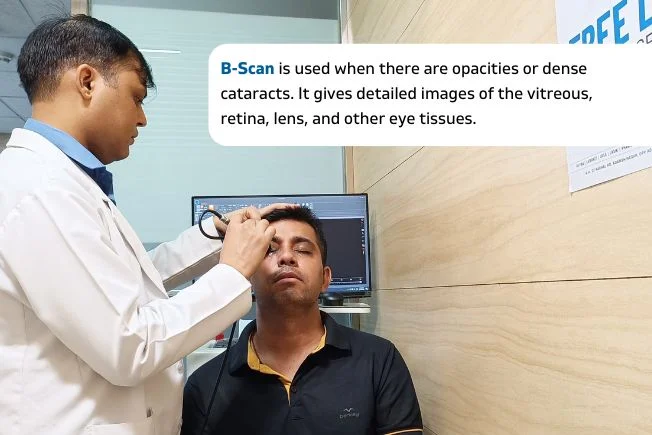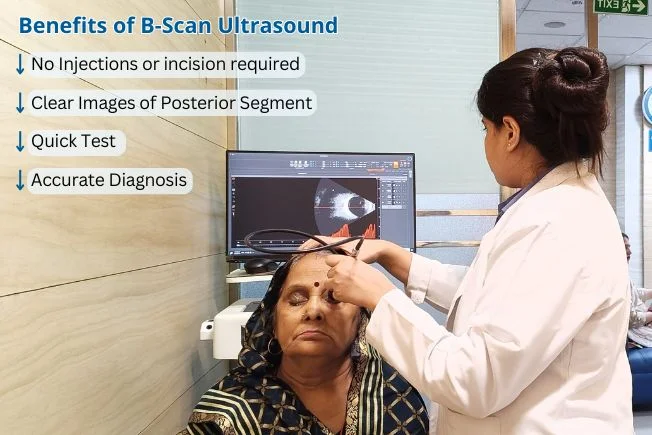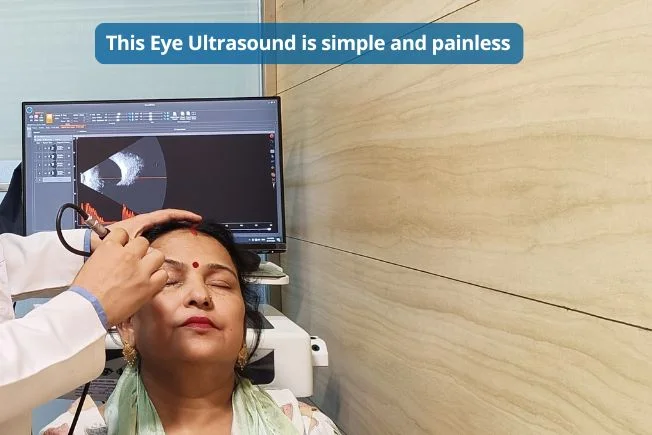B-scan ultrasound provides an invaluable means of monitoring retinal health in cases such as mature cataract or vitreous haemorrhage where vision cannot be assessed properly through traditional slit-lamp methods alone. When this occurs, doctors cannot properly assess your retinal health, which makes B-scan essential.
It shows if the retina is in place or if there are any serious problems. If you're looking for this test in North Delhi, you can visit Save Sight Centre in Adarsh Nagar, which is NABH and ISO accredited. They have experienced eye surgeons to guide you. B-scan ultrasound is safe, painless, and doesn't use radiation.

During the procedure, a gel is applied to the surface of the eye, and a small probe is used to transmit sound waves. The reflected waves create an image of the eye’s internal structures, which can then be analyzed by an ophthalmologist.
B-Scan eye ultrasound is recommended for patients with symptoms like sudden vision loss, eye pain, or suspected retinal issues. It helps in diagnosing conditions such as:

1. Preparation for the Test Before the test, you may be asked to remove any eye makeup or contact lenses. The procedure is painless.
2. During the Test The test is conducted while you sit on a comfortable chair. A probe will be gently placed on the surface of your eye, and you may be asked to look in different directions.
3. After the Test There are no special aftercare requirements, and you can resume your normal activities immediately. Your eye doctor will review the results and discuss them with you.

| Feature | A-Scan Ultrasound | B-Scan Ultrasound |
|---|---|---|
| Purpose | Measures the length of the eye | Provides a 2D image of the eye's structure |
| Main Use | Helps calculate the power of intraocular lenses for cataract surgery | Detects eye problems like retinal detachment, tumors, and foreign objects |
| Image Type | One-dimensional (1D) | Two-dimensional (2D) |
| Details Provided | Focuses on measurements (size, length) | Gives a detailed image of internal structures |
| Procedure | Probe placed on the surface of the eye | Probe placed on the eyelid (closed eye) |
| When Used | Pre-cataract surgery | For diagnosing eye conditions when the view is blocked by cataracts or other issues |
If you are in North Delhi and seek advanced technology, highly qualified staff, and commitment to quality diagnostics services, then Save Sight Centre would be the best option for you.
We have treated more than 1,40,000 patients in past 13+ Years. You can rely on us for your proper eye care.
Ans: B-scan ultrasound is a test that uses sound waves to create images of the inside of your eye, helping doctors see behind or inside the eye when it’s not visible.
Ans: A-scan measures the length of the eye, while a B-scan creates detailed images of the eye's internal structures, showing more detail.
Ans: Yes, B-scan eye ultrasound is safe. It is non-invasive and uses sound waves, which are harmless, can be done in new born infant and pregnant females.

Ans: The test usually takes between 5-10 minutes.
Ans: No special preparation is needed. You may be asked to keep your eye still or look in different directions during the test.
Ans: In most cases, your doctor can discuss the results with you shortly after the test is completed.
Copyright © 2025 | Save Sight Centre | All Rights Reserved.